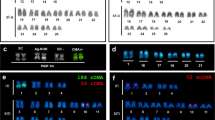Abstract
Epallage fatime (Charp.) is the first member of the family studied cytologically. The chromosome number is: 2n ♂=25,n ♂=13. The sex element is the smallest of the set at all stages of the spermatogenetic cycle. It is usually negatively heterocyclic at spermatogonial metaphase, whereas it is positively heteropyenotic at primary spermatocyte prophase and diakinesis.
While the cytological similarities betweenEpallagidae, Hetaerinidae andCalopterygidae suggest their close mutual affinities, the three differ essentially from thePolythoridae. This view is only partly in agreement with the evidence on the structural and venational characters (ct.Fraser, 1954).
Contrary toFraser's opinion (Fraser, 1957), thePseudolestidae can not be regarded, on the basis of the cytological information available, as an annectent family to the Calopterygoidea, but stand well apart from all other cytologically known Zygoptera.
Similar content being viewed by others
References
Buchholz K. (1967).Odonaia. In: J. Illies, Limnofauna Europaea, pp. 230–235. Fiseher, Stuttgart.
Cumming, R. B., (1964). Cytogenetic studies in the order Odonata. Thesis, Univ. of Texas.
Fraser F. C. (1934). Odonata. Pt. II. The fauna of British India including Ceylon and Burma. Taylor & Francis, London.
Fraser F. C. (1954). The origin and descent of the orderOdonata based on the evidence of persistent archaic characters.Trans. R. Ent. Soc. Lond. (B)23: (5–6) 89–94.
Fraser F. C. (1957). A reclassification of the order Odonata. R. Zool. Soc. New South Wales, Sydney.
Kiauta B. (1967). Considerations on the evolution of the chromosome complement inOdonata.Genetica 38: 430–446.
Kiauta B. (1968). Variation in size of the dragonfly m-chromosome, with considerations on its significance for the chorogeography and taxonomy of the orderOdonata, and notes on the validity of the rule ofReinig.Genetica 39: 64–74.
Kiauta B. (1969b). Sex chromosomes and sex determining mechanisms inOdonata, with a review of the cytological conditions in the familyGomphidae, and references to the karyotypic evolution in the order.Genetica 40: 127–157.
Kiauta B. (1969b). Autosomal fragmentations and fusions inOdonata and their evolutionary implications.Genetica 40: 158–180.
Kiauta, B. (1971). Annotated cytotaxonomic catalogue of the orderOdonata. Bibl. Genet. (In preparation).
Popova A. N. (1953). Lichinki strekoz fauny SSSR (Odonata) (Dragonfly larvae of the fauna of the USSR). Akad. Nauk SSSR, Moscow-Leningrad (In Russian).
Author information
Authors and Affiliations
Additional information
InCharpentier's original description (1840.Lib. Eur., pp. 132–134, pl. 45, fig. 2) the specific name is spelled asfatime and notfatima as cited erroneously byFraser (1934 pp. 76–78, figs. 22, 23 a, b). The spellingfatima byKirby (1890.Cat. Odon., p. 108) is therefore wrong.
Rights and permissions
About this article
Cite this article
Kiauta, B. The karyotype of the damselfly,Epallage fatime (Charpentier, 1840) (Odonata, Zygoptera:Epallagidae), with a note on the cytotaxonomic affinities in the superfamily calopterygoidea. Genetica 41, 525–531 (1970). https://doi.org/10.1007/BF00958931
Received:
Issue Date:
DOI: https://doi.org/10.1007/BF00958931



